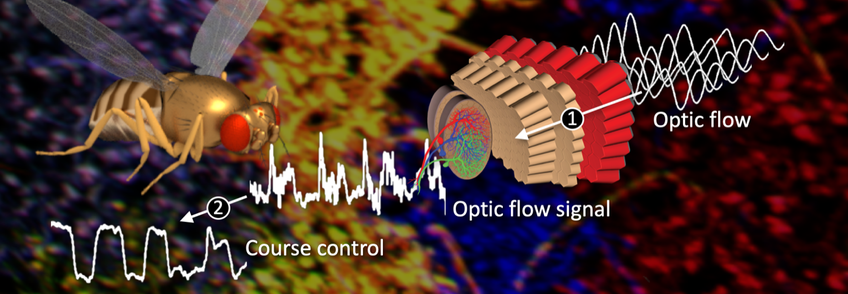
Neuroethology of Motion Vision
Project leader: Alex Mauss
Flow-field selectivity of wide-field neurons

Lobula plate output neurons (tangential cells) signal the presence of certain flow fields (Krapp & Hengstenberg, 1996). They receive two major kinds of inputs: excitatory local motion signals from cholinergic T4/T5 neurons (Schnell et al., 2012; Mauss et al., 2014) as well as feed-forward inhibition tuned to opposite directions via LPi neurons (Mauss et al., 2015). In combination with spatial integration, this simple connectivity motive ensures that tangential cells do not respond to any pattern containing preferred direction motion somewhere in the receptive field but rather selectively only to matching flow fields such as panoramic downward motion (Figure 1) (Mauss et al., 2015). Using electrophysiology and genetic circuit manipulation, we are investigating the connectivity and mechanisms that generate these and other response types.
Locomotor control by wide-field neurons in tethered flies

Optic flow-sensing neurons such as Horizontal System (HS) cells signal opposite directions of motion with graded de- and hyperpolarization (Hausen, 1984; Schnell et al., 2010). They are long thought to stabilize movement trajectories by sensing optic flow patterns arising from ego-motion and eliciting counteractive turning behavior. We are conducting experiments to study the effects of HS cell stimulation on tethered walking and flight. To gain control over the HS cells’ membrane potential, we express light-activatable optogenetic channels in those (Haikala et al., 2013; Mauss et al., 2017; Busch et al., 2018). For example, if depolarization is superimposed unilaterally on the HS cell potential, the animal will react with turning such that the simulated optic flow would be reduced. Interestingly, hyperpolarization also evokes turning: opposite to depolarization but again syndirectional with the simulated visual movement direction (Busch et al., 2018). Therefore, HS cells act as bidirectional optic flow sensors whose responses are likely useful to stabilize gaze and heading under natural conditions (Figure 2).
Roles of direction-selective neurons in freely moving flies
Studying visual behavior in tethered flies has many experimental advantages such as precise control over visual or optogenetic stimuli. However, tethered behavior is also unnatural. The animal is forced to behave in certain ways and sensory feedback from self-motion is either lacking or untypical. We therefore explore the natural role of motion vision and specific neuronal elements for behavior by combining genetic manipulations with automated tracking of freely walking and flying flies (Movie).
Tracking of walking flies
References
Busch C, Borst A, Mauss A (2018) Bi-directional control of walking behavior by horizontal optic flow sensors. Curr Biol 28: 4037–4045.
Hausen K (1984) The lobula-complex of the fly: structure, function and significance in visual behaviour. Photoreception and Vision in Invertebrates (Chapter 15):523–559.
Krapp HG, Hengstenberg R (1996) Estimation of self-motion by optic flow processing in single visual interneurons. Nature 384(6608):463–466.
Mauss AS, Busch C, Borst A (2017) Optogenetic neuronal silencing in Drosophila during visual processing. Sci Reports 7: 13823.
Mauss AS, Meier M, Serbe E, Borst A (2014) Optogenetic and pharmacologic dissection of feedforward inhibition in Drosophila motion vision. J Neurosci 34: 2254-2263.
Mauss AS, Pankova K, Arenz A, Nern A, Rubin GM, Borst A (2015) Neural circuit to integrate opposing motions in the visual field. Cell 162: 351-362.
Haikala V, Joesch M, Borst A, Mauss AS (2013) Optogenetic control of fly optomotor responses. J Neurosci 33: 13927-13934.
Schnell B, Joesch M, Forstner F, Raghu SV, Otsuna H, Ito K, Borst A, Reiff DF (2010) Processing of horizontal optic flow in three visual interneurons of the Drosophila brain. J Neurophysiol 103: 1646-1657.
Schnell B, Raghu SV, Nern A, Borst A (2012) Columnar cells necessary for motion responses of wide-field visual interneurons in Drosophila. J Comp Physiol A 198: 389-395.

